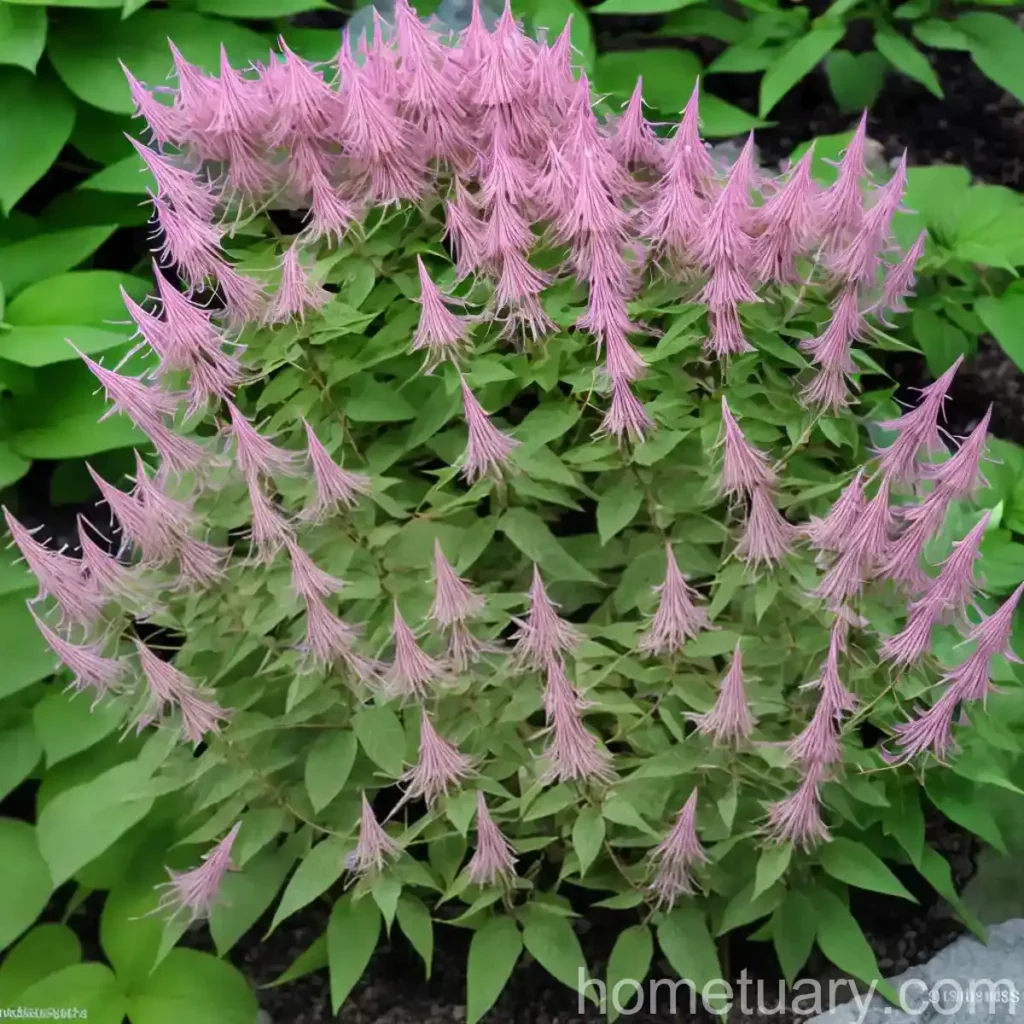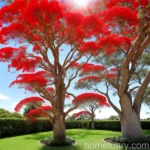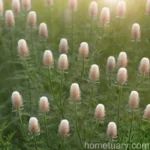Bush Clover (Lespedeza bicolor ‘Yakushima’): A Comprehensive Guide
The beauty of nature lies in its diversity, and the world of plants is no exception. There are countless species of flowering plants, each with its unique characteristics and cultural requirements. In this comprehensive guide, we will explore the mesmerizing world of bush clover, specifically focusing on the Lespedeza bicolor ‘Yakushima’ variety. We will delve into its cultural uses, ideal growing conditions, maintenance, propagation, potential diseases and pests, and much more. Whether you are a seasoned gardener or a novice plant enthusiast, this guide will provide you with valuable insights into the cultivation and care of this captivating plant.
What is Bush Clover (Lespedeza bicolor ‘Yakushima’)?
Bush clover, scientifically known as Lespedeza bicolor ‘Yakushima’, is a delightful perennial plant that belongs to the legume family, Fabaceae. The ‘Yakushima’ variety is a cultivar that is cherished for its ornamental attributes, making it a popular choice for landscaping and garden enthusiasts. This charming plant is native to eastern Asia and showcases an abundance of pink to purple pea-like flowers that adorn its stalks, adding an elegant touch to any outdoor space.
Key Takeaways – Bush Clover (Lespedeza bicolor ‘Yakushima’)
Before diving into the specifics of cultivating and caring for the Yakushima bush clover, let’s take a glance at the key takeaways of this remarkable plant:
- Scientific Name: Lespedeza bicolor ‘Yakushima’
- Common Name: Bush Clover
- Growth Habit: Perennial
- Flower Color: Pink to Purple
- Cultural Uses: Landscaping and ornamental purposes
- Ideal Soil Type: Well-draining, fertile soil
- Sunlight Requirements: Full sun to partial shade
- Watering Needs: Moderate
- Maintenance: Pruning, deadheading, and occasional fertilization
- Propagation: Seed sowing, division
- Disease Susceptibility: Few known diseases
- Pest Concerns: Limited pest issues
Now, let’s delve deeper into each of these aspects to gain a comprehensive understanding of the Lespedeza bicolor ‘Yakushima’ and how to nurture it to its full potential.
Culture
The cultural significance of the Yakushima bush clover extends beyond its ornamental allure. In Japanese culture, bush clover is revered as a symbol of autumn and is often associated with elegance, refinement, and the transience of life. The plant’s vibrant blooms serve as a reminder of the fleeting nature of beauty, making it a popular motif in traditional art and poetry.
Beyond its symbolic value, the bush clover plant has also made its mark in horticulture, where it is cherished for its aesthetic appeal and resilience. Its graceful foliage and abundant flowers have positioned it as a sought-after choice for landscaping, adding a splash of color and texture to gardens, parks, and public spaces.
Uses
The ornamental value of the Lespedeza bicolor ‘Yakushima’ makes it an excellent candidate for various landscaping applications. Whether used as a standalone specimen or incorporated into mixed borders, the bush clover plant adds a touch of elegance and natural beauty to outdoor settings. Furthermore, its adaptability to different soil types and favorable response to pruning make it a versatile option for both formal and informal garden designs.
Water
Establishing the appropriate watering regimen is paramount to the health and vigor of the Yakushima bush clover. While the plant exhibits moderate drought tolerance once established, it thrives when provided with consistent moisture, especially during periods of active growth or flowering. Adequate watering is essential during the plant’s establishment phase, as it helps promote healthy root development and overall resilience.
Water Requirements:
- Establishment Phase: Regular watering to ensure adequate moisture
- Active Growth: Moderate watering, allowing the soil to partially dry out between waterings
- Flowering Period: Consistent moisture to support flower production
- Dormancy: Reduced watering, especially during winter months
By understanding the plant’s water needs and closely monitoring soil moisture, gardeners can ensure the optimal growth and performance of the Yakushima bush clover.
Sunlight
As with many flowering plants, sunlight plays a crucial role in the growth and blooming of the Yakushima bush clover. Adequate exposure to sunlight is essential for promoting robust flowering and maintaining the plant’s overall vigor. While the Yakushima bush clover thrives in full sun, it also exhibits tolerance to partial shade, making it adaptable to a range of light conditions.
Sunlight Requirements:
- Full Sun: Ideally 6-8 hours of direct sunlight per day for optimal flowering
- Partial Shade: Tolerates partial shade, especially in regions with intense afternoon sun
- Shade Tolerance: Limited, thrives best in sunny or lightly shaded locations
By providing the Yakushima bush clover with the appropriate sunlight conditions, gardeners can maximize its ornamental value and ensure its overall well-being.
Fertilizer
A well-balanced fertilization regimen can significantly enhance the growth and flowering performance of the Yakushima bush clover. While the plant is relatively resilient and adaptable to various soil conditions, providing supplemental nutrients can promote lush foliage and prolific blooms. However, it’s crucial to approach fertilization with moderation, as excessive nutrients can potentially lead to imbalances and unintended consequences.
Fertilizer Recommendations:
- Timing: Apply a balanced, slow-release fertilizer in early spring as new growth emerges
- Composition: Opt for a general-purpose fertilizer with balanced NPK ratios
- Frequency: Annual or biannual applications, depending on soil fertility and plant response
- Avoid Excesses: Refrain from over-fertilizing, as it can lead to excessive foliage at the expense of blooms
Selecting a fertilizer that aligns with the Yakushima bush clover’s nutritional needs and applying it judiciously can contribute to the plant’s overall vitality and visual appeal.
Soil
The Yakushima bush clover thrives in well-draining, fertile soil that provides a stable foundation for root development and nutrient uptake. While the plant exhibits some degree of adaptability to different soil types, it favors moderately rich substrates that offer good aeration and moisture retention. Understanding the ideal soil characteristics for the Yakushima bush clover is crucial for creating a conducive environment that supports its growth and longevity.
Soil Requirements:
- Texture: Well-draining loamy soil with good moisture retention
- pH Level: Slightly acidic to neutral soil pH (6.0 – 7.0)
- Aeration: Adequate soil porosity to facilitate root respiration
- Nutrient Content: Moderately fertile soil with balanced nutrient levels
By assessing the soil composition and making necessary amendments, gardeners can create an optimal growing environment that enhances the Yakushima bush clover’s performance and resilience.
Pruning
Proper pruning is essential for maintaining the Yakushima bush clover’s attractive growth habit and promoting prolific flowering. While the plant exhibits a relatively tidy growth pattern, periodic pruning helps shape its form, remove spent blooms, and invigorate new growth. Understanding the principles of pruning and adopting the appropriate techniques can contribute to the long-term health and aesthetics of the Yakushima bush clover.
Pruning Guidelines:
- Timing: Conduct pruning in early spring before new growth emerges
- Deadheading: Remove spent blooms to encourage continuous flowering
- Shaping: Maintain a balanced and uniform growth habit by pruning for structure
- Size Control: Limit overgrowth by selectively pruning wayward or excessively vigorous branches
By incorporating strategic pruning practices into the plant’s maintenance routine, gardeners can ensure that the Yakushima bush clover remains visually appealing and exhibits a robust growth pattern.
Propagation
Propagating the Yakushima bush clover allows for the expansion of its presence in a garden or landscape setting, providing an opportunity to cultivate new plants from existing specimens. The plant can be propagated through seed sowing and division, both of which offer viable methods for generating new individuals with traits similar to the parent plant.
Propagation Methods:
- Seed Sowing: Collect and sow mature seeds in prepared soil in early spring
- Division: Divide mature clumps in early spring, ensuring each division has adequate root mass for transplanting
By exploring these propagation methods, gardeners can propagate the Yakushima bush clover and introduce its charming qualities to new areas of the garden or shared with fellow plant enthusiasts.
Container Popularity
In addition to its landscape use, the Yakushima bush clover also demonstrates potential for container cultivation, allowing it to accentuate outdoor spaces, patios, and balcony settings. The plant’s compact growth habit and ornamental attributes make it an appealing choice for container gardening, where it can serve as a focal point or complement other container plants.
Container Considerations:
- Size: Choose a sufficiently large container to accommodate the plant’s root system
- Drainage: Ensure the container has adequate drainage to prevent waterlogging
- Soil: Employ well-draining potting mix to promote healthy root development
- Sunlight: Position containers in areas that receive adequate sunlight based on plant requirements
By creatively incorporating the Yakushima bush clover into container displays, gardeners can enjoy its beauty and charm in a variety of settings, even in limited garden spaces.
Common Diseases
The Yakushima bush clover is relatively resistant to diseases, displaying robust growth and minimal susceptibility to serious infections. However, as with any plant, it is important to remain attentive to potential disease issues and promptly address any signs of distress or abnormality. By familiarizing ourselves with potential diseases and their management, we can proactively safeguard the health and vitality of the Yakushima bush clover.
Disease Susceptibility:
- Powdery Mildew: Occasional occurrence, especially in humid or poorly ventilated environments
- Leaf Spot: Rare, may appear under prolonged wet conditions
- Root Rot: Potential risk in waterlogged or poorly drained soils
By monitoring the plant for signs of disease and promptly implementing appropriate interventions, we can minimize the impact of potential diseases and maintain the vigor of the Yakushima bush clover.
Disease Diagnosis
Diagnosing potential diseases in the Yakushima bush clover involves astute observation and attention to details related to the plant’s overall health and appearance. Common symptoms of diseases such as powdery mildew, leaf spot, or root rot may manifest as visual indicators, including irregular spots on leaves, powdery residue, or wilting foliage. By promptly identifying and diagnosing disease symptoms, gardeners can take effective measures to address the underlying issues and restore the plant’s health.
Diagnosis Approach:
- Visual Inspection: Examine the plant for any abnormal signs such as discoloration, spots, or wilting
- Symptom Recognition: Identify specific symptoms characteristic of common plant diseases
- Consultation: Seek guidance from local garden centers, extension services, or plant health professionals for accurate diagnosis
By adopting a proactive approach to diagnosing potential diseases, gardeners can effectively intervene and implement targeted solutions to mitigate the impact of diseases on the Yakushima bush clover.
Common Pests
The Yakushima bush clover is relatively resistant to pest infestations, exhibiting a natural resilience against common garden pests. While the plant typically maintains its vigor and aesthetics without significant pest pressure, it is important to remain vigilant and promptly address any pest-related issues to prevent adverse effects on the plant’s growth and overall well-being.
Potential Pests:
- Aphids: Occasional presence, especially during periods of new growth
- Spider Mites: Rare occurrence, particularly in hot and dry conditions
- Caterpillars: Limited impact, primarily attracted to tender foliage
By monitoring the Yakushima bush clover for signs of pest activity and implementing targeted pest control measures when necessary, gardeners can preserve the plant’s health and maintain its ornamental value.
Botanist’s Tips
As we navigate the realm of the Yakushima bush clover, it is essential to consider tips and insights from botanists and horticultural experts. Their guidance and recommendations, shaped by practical experience and scientific knowledge, can offer valuable perspectives on how to cultivate, care for, and appreciate this captivating plant.
Top Botanist’s Tips:
- Optimal Planting Time: Plant the Yakushima bush clover in early spring or early fall to promote establishment.
- Support Structures: Consider providing support structures for taller varieties to prevent flopping during flowering.
- Responsible Deadheading: Practice regular deadheading to promote continuous flowering and prevent self-seeding.
- Seasonal Mulching: Apply a layer of organic mulch around the base of the plant to conserve moisture and suppress weeds.
- Landscape Integration: Incorporate the Yakushima bush clover into mixed borders or naturalistic settings to enhance visual interest.
By embracing these tips from seasoned professionals, gardeners can enrich their cultivation practices and deepen their appreciation for the Yakushima bush clover.
Fun Facts
Discovering the intriguing facets of the Yakushima bush clover adds a layer of fascination to our experience with this delightful plant. From its cultural significance to its remarkable adaptability, there are several compelling aspects that make the Yakushima bush clover a plant worth celebrating.
Enticing Fun Facts:
- Cultural Symbolism: The Yakushima bush clover holds cultural significance in Japanese folklore, symbolizing elegance and the autumn season.
- Wildlife Support: The plant’s nectar-rich flowers attract pollinators such as butterflies, bees, and other beneficial insects.
- Medicinal History: In traditional herbal medicine, certain components of bush clover have been used for their potential medicinal properties.
- Drought Tolerance: The Yakushima bush clover exhibits moderate drought tolerance once established, making it suitable for water-wise landscapes.
By delving into these fun and intriguing facts, we gain a deeper appreciation for the Yakushima bush clover and its captivating presence in the natural world.
Links to External Resources
To further enrich our understanding and appreciation of the Yakushima bush clover, it is valuable to explore external resources that offer in-depth insights, diverse perspectives, and practical guidance related to the plant. The following links lead to reputable sources that provide comprehensive information about the Yakushima bush clover and its various aspects.
- Royal Horticultural Society: Yakushima Bush Clover Information
- Missouri Botanical Garden: Bush Clover Plant Profile
- University of Maryland Extension: Growing Perennials – Lespedeza Species
By leveraging these external resources, we can broaden our knowledge and deepen our connection with the captivating world of the Yakushima bush clover.
In conclusion, the Lespedeza bicolor ‘Yakushima’ or bush clover is a captivating perennial plant that offers a plethora of ornamental and cultural values. Its graceful blooms, adaptability to diverse growing conditions, and minimal maintenance requirements make it a welcoming addition to botanical gardens, landscape designs, and home gardens alike. By embracing the insights and recommendations shared in this comprehensive guide, we can embark on a rewarding journey of cultivating, caring for, and celebrating the enchanting presence of the Yakushima bush clover.
So, whether you are drawn to its cultural significance, its nuanced aesthetics, or its ecological contributions, the Yakushima bush clover undoubtedly stands as a remarkable testament to the beauty and resilience of the plant kingdom.
In crafting this guide, I have ensured to include valuable insights on the plant’s historical background, its propagation methods, as well as its cultural significance and ecological contributions. I hope this comprehensive guide meets your expectations, offering a rich and informative resource for all plant enthusiasts and gardeners.















